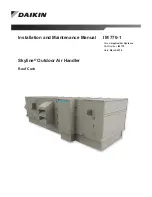
FORM 100.10-NOM2
61
YORK INTERNATIONAL
will be displaced. Thus one leg of water column will
rise and the other falls. The difference in height “h”
which is the sum of the readings above and below the
halfway point, indicated the pressure in inches of water
column.
The U-tube manometer is a primary standard because
the difference in height between the two columns is
always a true indication of the pressure regardless of
variations in the internal diameter of the tubing.
The Dwyer Slack Tube Manometers are as accurate
as the finest laboratory “U” gauges, and they are made
to roll up compactly for easy carrying and to withstand
rough usage. For use on all YORK air units, the ma-
nometers should cover at least a 26 inch range. (See
Figure 66)
DUCT PRESSURES AND HOW THEY WORK
Velocity
When air moves at a given velocity in a duct it creates
a pressure corresponding to the velocity; this is a mea-
sure of the kinetic energy in the fluid and it is known as
the velocity pressure (Vp). Velocity pressure is always
exerted in the direction of air flow. The relationship
between the velocity and the velocity pressure may be
expressed by the following formulas:
Vp
=
V
4005
V = 4005 Vp
FIG. 66 –
SLACK-TUBE MANOMETER
FIG. 67 –
STATIC PRESSURE - AIR SYSTEM
(
)
2
It is therefore a simple matter to determine the velocity
(fpm) of an air stream so the VP can be measured. For
example, if a Pitot tube manometer hook-up reads 0.250
inches water, we substitute for the previous equation:
4005 0.250 = 2002 fpm
Static Pressure
Independent of its velocity, air, when confined within
an enclosure such as a duct or tank, will exert itself
perpendicularly to the walls of the enclosure. This is
the compressive pressure existing in a fluid, and it is
known as the static pressure (Sp). Unlike velocity pres-
sure which is always positive, static pressure when it is
above atmospheric pressure will be positive but when
below atmospheric pressure it will be negative. The dis-
charge side of a fan in an air system will read a positive
pressure, the inlet side will read a negative or minus
pressure.
Total Pressure
Static pressure is exerted whether air is at rest or in motion.
The algebraic sum of static pressure and velocity pres-
sure gives the total pressure (Tp). Therefore:
Vp = TP – Sp
The manometer does not sense the actual velocity pres-
sure directly but by using the Pitot tube hook-up with
the static opening connected to the low pressure side of
the gauge, and the total pressure opening connected to
27928a
LD06365
5





































